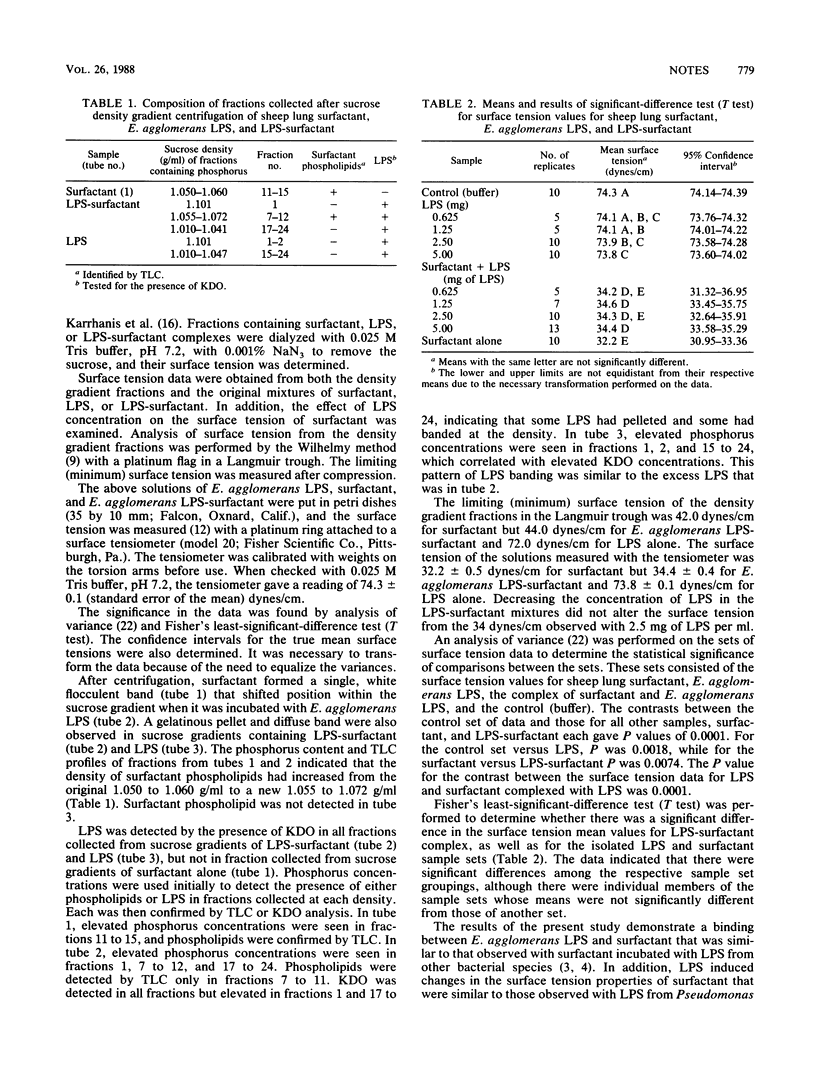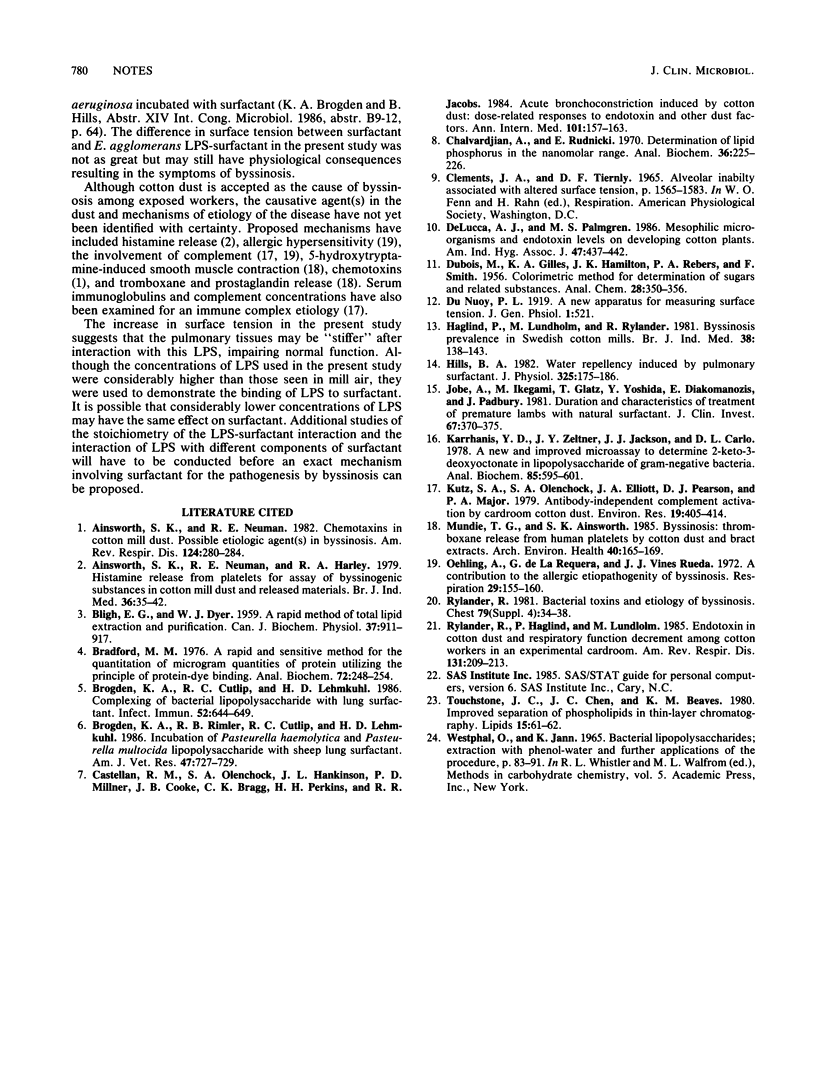Abstract
Lipopolysaccharide (LPS) from Enterobacter agglomerans and pulmonary surfactant mixtures were centrifuged in discontinuous sucrose gradients to determine whether LPS bound to surfactant and examined in a Langmuir trough with a Wilhelmy balance to determine whether LPS altered the surface activity of surfactant. The LPS was found to bind to the surfactant and altered its surface tension properties. The binding of LPS to surfactant in the lung may change the physiological properties of surfactant and be a possible mechanism for the pathogenesis of byssinosis.
Full text
PDF


Selected References
These references are in PubMed. This may not be the complete list of references from this article.
- Ainsworth S. K., Neuman R. E. Chemotaxins in cotton mill dust: possible etiologic agent(s) in byssinosis. Am Rev Respir Dis. 1981 Sep;124(3):280–284. doi: 10.1164/arrd.1981.124.3.280. [DOI] [PubMed] [Google Scholar]
- Ainsworth S. K., Neuman R. E., Harley R. A. Histamine release from platelets for assay of byssinogenic substances in cotton mill dust and related materials. Br J Ind Med. 1979 Feb;36(1):35–42. doi: 10.1136/oem.36.1.35. [DOI] [PMC free article] [PubMed] [Google Scholar]
- BLIGH E. G., DYER W. J. A rapid method of total lipid extraction and purification. Can J Biochem Physiol. 1959 Aug;37(8):911–917. doi: 10.1139/o59-099. [DOI] [PubMed] [Google Scholar]
- Bradford M. M. A rapid and sensitive method for the quantitation of microgram quantities of protein utilizing the principle of protein-dye binding. Anal Biochem. 1976 May 7;72:248–254. doi: 10.1016/0003-2697(76)90527-3. [DOI] [PubMed] [Google Scholar]
- Brogden K. A., Cutlip R. C., Lehmkuhl H. D. Complexing of bacterial lipopolysaccharide with lung surfactant. Infect Immun. 1986 Jun;52(3):644–649. doi: 10.1128/iai.52.3.644-649.1986. [DOI] [PMC free article] [PubMed] [Google Scholar]
- Brogden K. A., Rimler R. B., Cutlip R. C., Lehmkuhl H. D. Incubation of Pasteurella haemolytica and Pasteurella multocida lipopolysaccharide with sheep lung surfactant. Am J Vet Res. 1986 Apr;47(4):727–729. [PubMed] [Google Scholar]
- Castellan R. M., Olenchock S. A., Hankinson J. L., Millner P. D., Cocke J. B., Bragg C. K., Perkins H. H., Jr, Jacobs R. R. Acute bronchoconstriction induced by cotton dust: dose-related responses to endotoxin and other dust factors. Ann Intern Med. 1984 Aug;101(2):157–163. doi: 10.7326/0003-4819-101-2-157. [DOI] [PubMed] [Google Scholar]
- Chalvardjian A., Rudnicki E. Determination of lipid phosphorus in the nanomolar range. Anal Biochem. 1970 Jul;36(1):225–226. doi: 10.1016/0003-2697(70)90352-0. [DOI] [PubMed] [Google Scholar]
- DeLucca A. J., 2nd, Palmgren M. S. Mesophilic microorganisms and endotoxin levels on developing cotton plants. Am Ind Hyg Assoc J. 1986 Aug;47(8):437–442. doi: 10.1080/15298668691390016. [DOI] [PubMed] [Google Scholar]
- Haglind P., Lundholm M., Rylander R. Prevalence of byssinosis in Swedish cotton mills. Br J Ind Med. 1981 May;38(2):138–143. doi: 10.1136/oem.38.2.138. [DOI] [PMC free article] [PubMed] [Google Scholar]
- Hills B. A. Water repellency induced by pulmonary surfactants. J Physiol. 1982 Apr;325:175–186. doi: 10.1113/jphysiol.1982.sp014143. [DOI] [PMC free article] [PubMed] [Google Scholar]
- Jobe A., Ikegami M., Glatz T., Yoshida Y., Diakomanolis E., Padbury J. Duration and characteristics of treatment of premature lambs with natural surfactant. J Clin Invest. 1981 Feb;67(2):370–375. doi: 10.1172/JCI110044. [DOI] [PMC free article] [PubMed] [Google Scholar]
- Karkhanis Y. D., Zeltner J. Y., Jackson J. J., Carlo D. J. A new and improved microassay to determine 2-keto-3-deoxyoctonate in lipopolysaccharide of Gram-negative bacteria. Anal Biochem. 1978 Apr;85(2):595–601. doi: 10.1016/0003-2697(78)90260-9. [DOI] [PubMed] [Google Scholar]
- Kutz S. A., Olenchock S. A., Elliott J. A., Pearson D. J., Major P. C. Antibody-independent complement activation by cardroom cotton dust. Environ Res. 1979 Aug;19(2):405–414. doi: 10.1016/0013-9351(79)90065-3. [DOI] [PubMed] [Google Scholar]
- Mundie T. G., Ainsworth S. K. Byssinosis: thromboxane release from human platelets by cotton dust and bract extracts. Arch Environ Health. 1985 May-Jun;40(3):165–169. doi: 10.1080/00039896.1985.10545911. [DOI] [PubMed] [Google Scholar]
- Oehling A., Gonzalez de la Reguera I., Viñes Rueda J. J. A contribution to the allergic ethiopathogenity of byssinosis. Respiration. 1972;29(2):155–160. doi: 10.1159/000192870. [DOI] [PubMed] [Google Scholar]
- Rylander R., Haglind P., Lundholm M. Endotoxin in cotton dust and respiratory function decrement among cotton workers in an experimental cardroom. Am Rev Respir Dis. 1985 Feb;131(2):209–213. doi: 10.1164/arrd.1985.131.2.209. [DOI] [PubMed] [Google Scholar]


